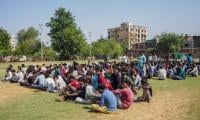In September 2018, heavy rains caused the banks of Bangladesh’s Padma River to collapse. The resulting floods swallowed as many as 100 homes a day in the Shariatpur District, an area south of Dhaka. The event was outlined in a recent report from the International Federation of Red Cross and Red Crescent Societies that looks at instances of climate-related displacement in Asia.
Over the past half-century, an area roughly five times the size of Dhaka has been lost to riverbank erosion along to the Padma and Jamuna rivers, according to a 2018 report. Floods have created a migration pipeline from rural areas to the capital's poorest neighborhoods, where displaced people continue to face floods. The report said that residents of urban slums have been hit especially hard by riverbank erosion.
“People might imagine that if your income goes up [and allows you to move] from a rural area to a city, that life will be better, yet that's hardly the situation,” said Harjeet Singh, global climate lead for the international nonprofit ActionAid. “Most migrants end up living in areas prone to floods, or that don’t have basic services, and will once again have a very low quality of life.”
Across Asia, people displaced by climate disasters continue to be vulnerable to climate-related threats. In April 2020, Tropical Cyclone Harold, a category 5 storm fueled by unusually warm waters in the South Pacific, swept through Tonga, Fiji and Vanuatu. Harold displaced more than one in four people in Vanuatu, many of whom fled to more populated areas in search of shelter, according to the Red Cross and Red Crescent report. Because of widespread damage to evaluation centers, people took to sleeping outdoors on concrete slabs, where they were exposed to the elements. In the days and weeks after the storm, hot, wet conditions fueled a malaria outbreak.
In the spring of 2018, much of Afghanistan saw its worst drought in a decade. Communities in the north and west that are reliant on farming lost crops and livestock amid the dry spell, depriving growers of needed income while leading to severe food shortages across the country. The drought displaced more than 370,000 people, forcing many to flee to refugee camps on the outskirts of nearby cities in search of safety and work.
“These are very, very poor communities,” said Nasratullah Elham, an Afghan climate activist who recently moved to the United States. “When a family loses their livestock, they've pretty much lost everything.”
Roughly a year after the drought hit, heavy rains fell on Afghanistan, leading to flash flooding that damaged or destroyed homes in rural areas, as well as refugee camps, displacing some 42,000 people, according to the Red Cross and Red Crescent report. Both drought and floods are becoming more frequent and intense in Afghanistan.
“When people move to the cities, they usually don’t go back,” Elham said. “But most really can't afford it and fall into poverty again, so it can be very, very tough.”
Excerpted: ‘Across Asia, People Displaced by Climate Disasters Continue to Be Vulnerable With Little Promise of Relief’
Commondreams.org
A voter casts vote in US. — AFP/FileThe Democratic Party has significant work to do if it hopes to bounce back from...
Palestinians gather to receive food from a charity kitchen, amid a hunger crisis, in Gaza City on July 23, 2025. —...
People walk past flags of Pakistan´s political parties displayed for sale at a market in Lahore on January 13, 2024,...
A man rides on a motorcycle amid flood waters along a road during the monsoon season in Rawalpindi, July 19, 2023. —...
People line up as election officials check their ballot papers during voting in the general election at a polling...
People hold placards as they take part in a "March for Clean Water" in London on November 3, 2024. — AFPThe recent...







